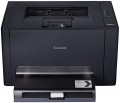Output type
The number of colours the printer produces when printing. To date, there are
monochrome(black and white) and
colour(providing full-colour printing) printers. The former are considered optimal for documents and other official materials that do not require colour; the latter allow you to create a full-fledged image, but such printing is much more expensive, so you should pay attention to them only if the colour format is critical.
Max. resolution
The maximum resolution of the image to be printed. It is usually indicated by two numbers denoting the number of dpi (DPI) horizontally and vertical:
600x600, 1200x600,
1200x1200,
2400x600,
2400x1200,
4800x600,
4800x1200,
4800x2400,
5760x1440,
9600x600,
9600x2400. The detail of the image depends on this parameter - the higher the resolution, the more fine details the printer is able to convey and the better their image will be. High print resolution is important, first of all, when working with graphic material; low resolution is sufficient for high-quality text display. So
First page print time
The time from the receipt of a print command to the exit from the printer of the first page printed in black and white, in other words, how long after pressing the "Print" button, the user will receive the first page. Most often indicated for draft (fastest) print mode, higher quality will take longer. You should pay attention to this parameter if you often need to print small documents (on one or several pages) on the printer.
Mono print
The black and white print speed provided by the printer. It should be noted that this parameter is often indicated for low quality when the device is running at maximum performance; at a higher quality (even at standard), the actual speed can be noticeably lower, so you should choose with a certain margin. Also note that high speed significantly affects the price, power consumption and noise level. Therefore, it does not always make sense to chase maximum performance — for simple applications (for example, at home or in a small office), a relatively slow and inexpensive device may be the best choice.
As for specific values, speeds
up to 20 ppm are considered relatively low,
20 – 30 ppm — average,
31 – 40 ppm — decent, and the fastest models are capable of delivering
more than 40 pages per minute.
Colour print
Colour print speed provided by the printer. Usually, the specifications give speed at low quality, when performance is highest; on standard and especially high settings, the print speed can be noticeably lower, so it’s worth choosing with a certain margin. It is also worth considering that high speed significantly affects the price, power consumption and noise level. Therefore, it does not always make sense to chase maximum performance — for simple applications and small print volumes, a relatively slow and inexpensive device may be the best choice.
The "slowest" colour printers today are capable of delivering
less than 10 pages per minute. A more decent value is considered
10 – 20 ppm, a speed
of more than 20 ppm can already be called quite good, and in the fastest models this figure
exceeds 30 ppm.
Duplex printing
Automatic duplex printing function .
In this mode, the user does not need to manually turn over each sheet and send it to print on the second side — this will be done by the printer mechanism, and materials printed on both sides will immediately enter the output tray. This not only saves time, but also eliminates confusion: a person can make a mistake and print one of the sides “upside down”, automation does not allow such errors.
Mono cartridge resource
The maximum number of pages that the printer's ink (toner) can print. The value is rather conditional, in reality the deviations from the norm are very large (up or down). In inkjet printers, the cartridge life is relatively small and amounts to several hundred prints. In laser and LED devices, the bill is already in the thousands.
Colour cartridge resource
The maximum number of pages that the printer's ink (toner) can print. The value is rather conditional, in reality the deviations from the norm are very large (up or down). In inkjet printers, the cartridge life is relatively small and amounts to several hundred prints. In laser and LED devices, the bill is already in the thousands.
Cartridges
The number of ink cartridges required for the full operation of the printer. In black and white devices, usually, one cartridge is installed. For colour printing, at least 4 colours are required (CMYK colour scheme), however, cartridges in such devices can be installed as 4 (one for each colour), or only 2 — black and "colour". The latter is essentially three multi-coloured cartridges in one case; This design somewhat reduces the cost, but creates certain inconveniences: when the supply of ink of one colour is exhausted, the entire colour cartridge becomes inoperative. However, this disadvantage is not critical if the possibility of refueling is provided.
Printers designed for more than 4 cartridges are also available. This design means that this model uses one of the extended colour schemes; this, on the one hand, contributes to high-quality colour reproduction, on the other hand, it significantly affects the price. In the most advanced photo printers, the number of cartridges can reach 9.

